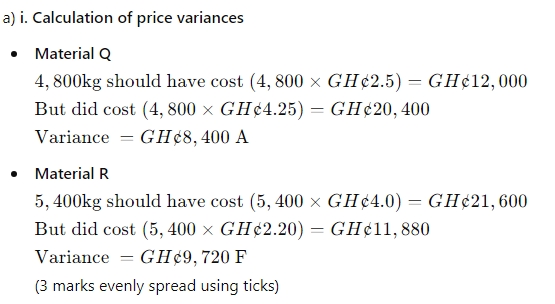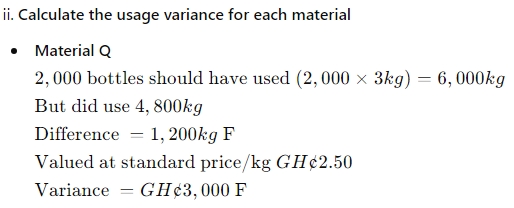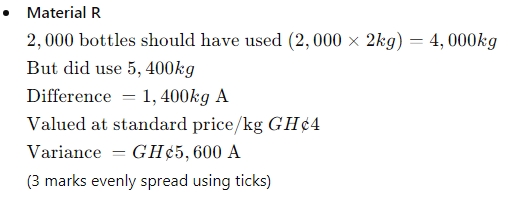- 15 Marks
Question
The following information relates to the estimate and actual results of Manjo Plc for the month of January:
| Particulars | KO | TO | KA |
|---|---|---|---|
| Budgeted sales (units) | 36,000 | 27,000 | 18,000 |
| Standard selling price (GH¢) | 15 | 10 | 12.5 |
| Standard variable cost (GH¢) | 8 | 4 | 7.5 |
| Actual sales (units) | 30,000 | 35,000 | 25,000 |
| Actual sales (GH¢) | 420,000 | 367,500 | 325,000 |
Required:
i) Calculate the sales price variance. (3 marks)
ii) Calculate the sales volume variance. (3 marks)
iii) Analyse the sales volume variance into:
- Sales quantity variance. (5 marks)
- Sales mix variance. (4 marks)
Answer
i) Sales Price Variance:
The sales price variance measures the impact of the difference between the actual selling price and the budgeted selling price on the actual units sold.
| Product | Calculation | Variance (GH¢) | Result |
|---|---|---|---|
| KO | (Budgeted Price – Actual Price) × Actual Units Sold | (15 – (420,000/30,000)) × 30,000 = 30,000 | Adverse |
| TO | (10 – (367,500/35,000)) × 35,000 | (10 – 10.5) × 35,000 = 17,500 | Favourable |
| KA | (12.5 – (325,000/25,000)) × 25,000 | (12.5 – 13) × 25,000 = 12,500 | Favourable |
Total Sales Price Variance = 30,000 Adverse + 17,500 Favourable + 12,500 Favourable = 5,000 Adverse
(Marks are evenly spread using ticks = 3 marks)
ii) Sales Volume Variance:
The sales volume variance shows the effect of the difference between actual sales volume and budgeted sales volume, valued at the standard contribution.
| Product | Budgeted Sales (Units) | Actual Sales (Units) | Volume Variance (Units) | Contribution per Unit (GH¢) | Variance (GH¢) |
|---|---|---|---|---|---|
| KO | 36,000 | 30,000 | 6,000 A | 7 | 42,000 A |
| TO | 27,000 | 35,000 | 8,000 F | 6 | 48,000 F |
| KA | 18,000 | 25,000 | 7,000 F | 5 | 35,000 F |
Total Sales Volume Variance = 41,000 Favourable
(Marks are evenly spread using ticks = 3 marks)
iii) Sales Quantity Variance:
The sales quantity variance measures the effect of the difference between the actual total sales and the budgeted total sales, valued at the standard contribution.
| Product | Budgeted Sales (Units) | Standard Contribution (GH¢) | Budgeted Contribution (GH¢) |
|---|---|---|---|
| KO | 36,000 | 7 | 252,000 |
| TO | 27,000 | 6 | 162,000 |
| KA | 18,000 | 5 | 90,000 |
| Total | 81,000 | 6.2222 | 504,000 |
| Actual Sales (Units) | Actual Contribution (GH¢) |
|---|---|
| 90,000 | 6.2222 |
| Variance | 56,000 Favourable |
(Marks are evenly spread using ticks = 5 marks)
iv) Sales Mix Variance:
The sales mix variance measures the effect of the deviation of the actual sales mix from the budgeted sales mix.
| Product | Actual Mix (Units) | Standard Mix (Units) | Mix Variance (Units) | Contribution per Unit (GH¢) | Variance (GH¢) |
|---|---|---|---|---|---|
| KO | 30,000 | 40,000 | 10,000 A | 7 | 70,000 A |
| TO | 35,000 | 30,000 | 5,000 F | 6 | 30,000 F |
| KA | 25,000 | 20,000 | 5,000 F | 5 | 25,000 F |
Total Sales Mix Variance = 15,000 Adverse
- Tags: mix variance, Price Variance, Quantity Variance, Sales Variance, Volume Variance
- Level: Level 2
- Topic: Standard Costing and Variance Analysis
- Series: MAR 2024
- Uploader: Joseph



